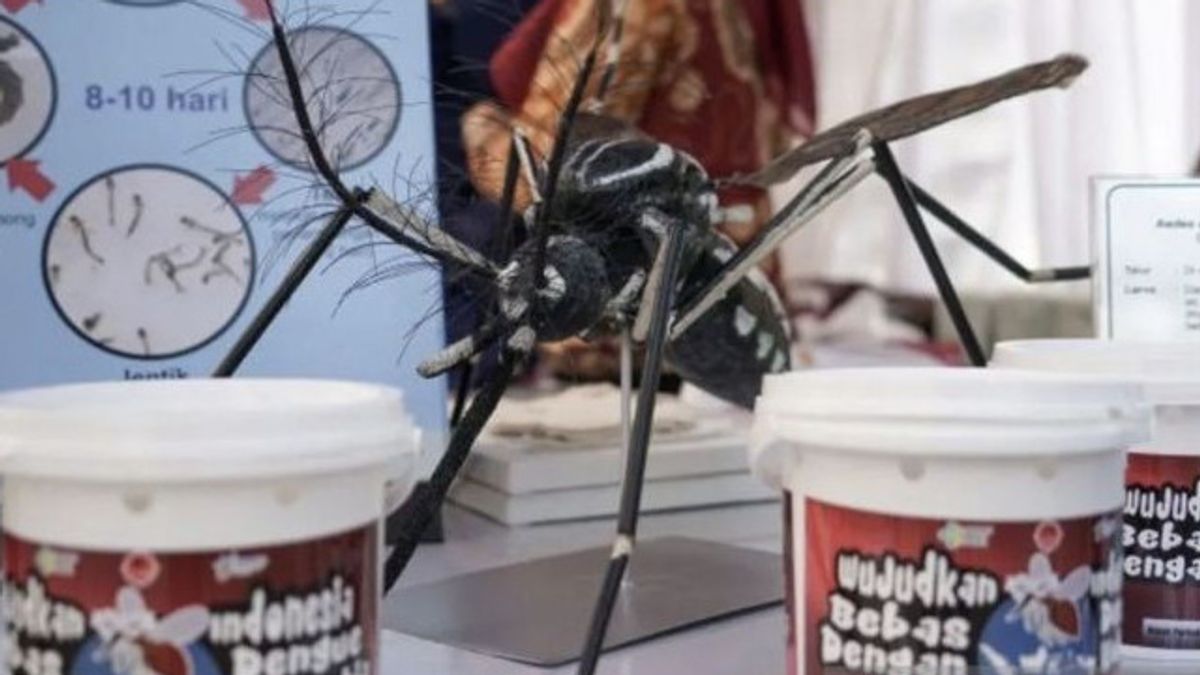JAKARTA - Director General of Disease Prevention and Control of the Ministry of Health, Maxi Rein Rondonuwu, emphasized that there is no relationship between the spread of wolbachia mosquitoes and the level of ferocity of the Aedes aegypti mosquito, which causes dengue fever.
According to him, the characteristics of the Aedes aegypti mosquito in areas that have been distributed or have not been distributed by wolbachia mosquitoes remain the same.
In addition, the signs and symptoms of people who are bitten by the Aedes aegypti mosquito are also the same, such as high fever followed by muscle aches, nausea, vomiting, headaches,guides, and bleeding gums.
"Overall, the characteristics and symptoms are the same. In fact, there is no difference in the number of Aedes aegypti mosquitoes before and after MARIJUANA was released," Maxi said as quoted by ANTARA, Tuesday, April 2.
Maxi revealed that the spread of wolbachia mosquitoes has proven to be effective in reducing cases of dengue fever in the city of Yogyakarta.
Since it was first distributed in 2017, he said, wolbachia mosquitoes have been shown to be able to reduce 77 percent of dengue events and 86 percent of hospital admissions.
According to the monitoring of the Ministry of Health and the health office in Semarang, Kupang, Bontang, Bandung, and West Jakarta, namely cities where wolbachia mosquitoes are distributed, the concentration of aedes aegypti mosquitoes with wolbachia in nature is in the range of 20 percent after release.
This figure, according to him, is still below the percentage of aeros aegypti wolbachia mosquitoes, which ideally reaches 60 percent in nature.
"After the population reaches 60 percent, the release of wolbachia mosquito buckets will be withdrawn and the results of the decline in dengue cases will only begin to appear after 2 years, 4 years, 10 years, and so on, as implemented in the city of Yogyakarta," he said.
Director General Maxi ensured that the application of the technology was safe because it utilized natural bacteria that were found in insects and had gone through relatively long research.
Research on radiobachia technology in Yogyakarta for 12 years, from 2011 to 2023. This research has passed four stages of research, starting from the eligibility and safety phase (2011 2012), the limited scale release phase (2013 2015), the broad scale release phase (2016 2020), and the implementation phase (20212022).
In the world, he said, the first study of the Wolbachia application for Dengue (AWED) Elimination in Yogyakarta with the design of the Cluster Randomized Controlled Trial (CRCT) is a design with the highest standards.
In Indonesia, he continued, risk analysis was initiated by the Ministry of Research and Technology and the Ministry of Health's Balitbangkes by involving 20 people from various expertise. The results of the analysis show that the release of a wolbachia mosquito has a very low risk.
"In the next 30 years, the chances of increasing the danger of the aedes aegypti wolbachia spread can be ignored (negligible)," he said.
SEE ALSO:
In 2023, WHO has recommended the use of aedes aegypti wolbachia mosquitoes.
Although the wolbachia mosquito has been distributed, Maxi appealed to the public to complete prevention efforts by implementing the eradication of mosquito nests (PSN) with 3M plus.
This step, according to him, can be done by draining water reservoirs, closing water reservoirs, and recycling various items that are at risk of being used as breeding grounds for Aedes aegypti mosquitoes that cause dengue hemorrhagic fever in humans.
The English, Chinese, Japanese, Arabic, and French versions are automatically generated by the AI. So there may still be inaccuracies in translating, please always see Indonesian as our main language. (system supported by DigitalSiber.id)
















